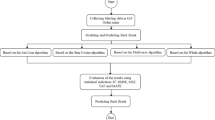Abstract
The back analysis method has been widely used as an indirect method of determining geotechnical parameters based on field measurements. The number of parameters and their initial values greatly influence the reliability and efficiency of back analysis. Therefore, sensitivity analysis is often employed to select high sensitivity parameters that have more greater impact on measured back analysis values. The orthogonal design method was first utilized to select geotechnical parameters for back analysis. The optimized parameter values obtained from an orthogonal design table can be used as the initial back analysis values, so as to avoid optimisation algorithm searching in local parameter spaces. By introducing a penalty function to the objective function, back analysis of the geotechnical parameters is changed into an unconstrained optimisation problem, whereby the Nelder–Mead method can then be employed. To verify the feasibility of the proposed back analysis method, a case study was conducted to determine the rock mass parameters for the Houziyan underground powerhouse complex.










Similar content being viewed by others
References
ABAQUS (2004) Analysis User’s Manual, Version 6.5
Bieniawski ZT (1978) Determining rock masses deformability: experience form case histories. Int J Rock Mech Min Sci Geomech Abstr 15(5):237–247
Calvello M, Finno RJ (2004) Selecting parameters to optimize in model calibration by inverse analysis. Comput Geotech 31(5):410–424
Eclaircy-Caudron S, Dias D, R. Kastner (2007) Inverse analysis on measurements realized during a tunnel excavation. In: Proc. ITA-AITES World Tunnel Congress, Prague
Feng XT, Zhao H, Li S (2004) A new displacement back analysis to identify mechanical geo-material parameters based on hybrid intelligent methodology. Int J Numer Anal Meth Geomech 28(11):1141–1165
Gioda G, Locatelli L (1999) Back analysis of the measurements performed during the excavation of a shallow tunnel in sand. Numer Anal Method Geomech 23:1407–1425
Ji L, Si Y, Liu H, Song X, Zhu W, Zhu A (2014) Application of orthogonal experimental design in synthesis of mesoporous bioactive glass. Micropor Mesopor Material 184:122–126
Levasseur S, Malecot Y, Boulon M, Flavigny E (2007) Soil parameter identification using a genetic algorithm. Int J Numer Anal Meth Geomech 32(2):189–213
Luersen MA, Le Riche R, Guyon F (2004) A constrained, globalized, and bounded Nelder-Mead method for engineering optimization. Struct Multidiscip Optim 27:43–54
Marquardt DW (1963) An algorithm for least-squares estimation of nonlinear parameters. Siam J Appl Math 11:431–441
Min KB, Jing L (2003) Numerical determination of equivalent elastic compliance tensor for fractured rock masses using the distinct element method. Int J Rock Mech Min Sci 40:795–816
Ministry of Housing and Urban-rural Development of China (1994) Standard for engineering classification of rock masses. China Water Power Press, Beijing
Miranda T, Dias D, Eclaircy-Caudron S, Gomes-Correia A, Costa L (2011) Back analysis of geotechnical parameters by optimization of 3D model of an underground structure. Tunn Undergr Space Technol 26(6):659–673
Montgomery DC (1991) Design and Analysis of Experiments, 3rd edn. Wiley, New York
Nelder JA, Mead R (1965) A simplex method for function minimization. Comput J 7:308–313
Oreste P (2005) Back-analysis techniques for the improvement of the understanding of rock in underground constructions. Tunn Undergr Space Technol 20:7–21
Phadke MS (1995) Quality engineering using robust design. Prentice Hall, Englewood Cliffs
Sakurai S, Akutagawa S, Takeuchi K, Shinji M, Shimizu N (2003) Back analysis for tunnel engineering as a modern observational method. Tunn Undergr Space Technol 18:185–196
Swoboda G, Ichikawa Y, Dong Q, Zaki M (1999) Back analysis of large geotechnical models. Int J Numer Anal Meth Geomech 23(13):1455–1472
Tian HM, Chen WZ, Yang DS, Yang JP (2014) Experimental and numerical analysis of the shear behaviour of cemented concrete–rock joints. Rock Mech Rock Eng. doi:10.1007/s00603-014-0560-6
Yang Z, Elgamal A (2003) Application of unconstrained optimization and sensitivity analysis to calibration of a soil constitutive model. Int J Numer Anal Meth Geomech 27(15):1277–1297
Yazdani M, Sharifzadeh M, Kamrani K, Ghorbani M (2012) Displacement-based numerical back analysis for estimation of rock mass parameters in Siah Bisheh powerhouse cavern using continuum and discontinuum approach. Tunn Undergr Space Technol 28:41–48
Yeniay Ö (2005) Penalty function methods for constrained optimization with genetic algorithms. Math Comput Appl 10(1):45–56
Zhang LQ, Yue ZQ, Yang ZF, Qi JX, Liu FC (2006) A displacement-based back-analysis method for rock mass modulus and horizontal in situ stress in tunneling-illustrated with a case study. Tunn Undergr Space Technol 21:636–649
Acknowledgments
The authors gratefully acknowledge the support of the Chinese Fundamental Research (973) Program through the Grant No. 2013CB036006 and the support of the National Natural Science Foundation of China (Grant Nos. 51309217, 51379200, 51225902 and 51274189). D. S. Yang acknowledges the support of the Chinese government plan for the Recruitment of Global Young Talents (1000 Young Talents Plan).
Author information
Authors and Affiliations
Corresponding author
Rights and permissions
About this article
Cite this article
Tian, H., Chen, W., Yang, D. et al. Application of the orthogonal design method in geotechnical parameter back analysis for underground structures. Bull Eng Geol Environ 75, 239–249 (2016). https://doi.org/10.1007/s10064-015-0730-0
Received:
Accepted:
Published:
Issue Date:
DOI: https://doi.org/10.1007/s10064-015-0730-0




